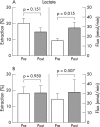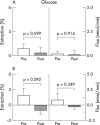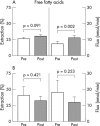Coronary blood flow, metabolism, and function in dysfunctional viable myocardium before and early after surgical revascularisation
- PMID: 15486124
- PMCID: PMC1768513
- DOI: 10.1136/hrt.2003.022327
Coronary blood flow, metabolism, and function in dysfunctional viable myocardium before and early after surgical revascularisation
Abstract
Objectives: To assess the link between perfusion, metabolism, and function in viable myocardium before and early after surgical revascularisation.
Design: Myocardial blood flow (MBF, thermodilution technique), metabolism (lactate, glucose, and free fatty acid extraction and fluxes), and function (transoesophageal echocardiography) were assessed in patients with critical stenosis of the left anterior descending coronary artery (LAD) before and 30 minutes after surgical revascularisation.
Setting: Tertiary cardiac centre.
Patients: 23 patients (mean (SEM) age 57 (1.7) years with LAD stenosis: 17 had dysfunctional viable myocardium in the LAD territory, as shown by thallium-201 rest redistribution and dobutamine stress echocardiography (group 1), and six had normally contracting myocardium (group 2).
Results: LAD MBF was lower in group 1 than in group 2 (58 (7) v 113 (21) ml/min, p < 0.001) before revascularisation and improved postoperatively in group 1 (129 (133) ml/min, p < 0.001) but not in group 2 (105 (20) ml/min, p = 0.26). Group 1 also had functional improvement in the LAD territory at intraoperative echocardiography (mean regional wall motion score from 2.6 (0.85) to 1.5 (0.98), p < 0.01). Oxidative metabolism, with lactate and free fatty acid extraction, was found preoperatively and postoperatively in both groups; however, lactate and free fatty acid uptake increased after revascularisation only in group 1.
Conclusions: MBF is reduced and oxidative metabolism is preserved at rest in dysfunctional but viable myocardium. Surgical revascularisation yields immediate perfusion and functional improvement, and increases the uptake of lactate and free fatty acids.
Figures






Comment in
-
Evaluation of hibernating myocardium.Heart. 2004 Nov;90(11):1239-40. doi: 10.1136/hrt.2004.035998. Heart. 2004. PMID: 15486110 Free PMC article. No abstract available.
Similar articles
-
Low dose dobutamine echocardiography for predicting functional recovery after coronary revascularisation.Heart. 2001 Dec;86(6):679-86. doi: 10.1136/heart.86.6.679. Heart. 2001. PMID: 11711467 Free PMC article.
-
Positron emission tomography for the assessment of myocardial viability: an evidence-based analysis.Ont Health Technol Assess Ser. 2005;5(16):1-167. Epub 2005 Oct 1. Ont Health Technol Assess Ser. 2005. PMID: 23074467 Free PMC article.
-
Positron emission tomography for the assessment of myocardial viability: an evidence-based analysis.Ont Health Technol Assess Ser. 2010;10(16):1-80. Epub 2010 Jul 1. Ont Health Technol Assess Ser. 2010. PMID: 23074393 Free PMC article.
-
MRI assessment of myocardial viability: comparison with other imaging techniques.Rays. 1999 Jan-Mar;24(1):96-108. Rays. 1999. PMID: 10358387 Review. English, Italian.
-
[Myocardial tissue vitality: clinical relevance, pathophysiology and identification].Ned Tijdschr Geneeskd. 1998 Jan 10;142(2):67-71. Ned Tijdschr Geneeskd. 1998. PMID: 9556996 Review. Dutch.
Cited by
-
Metabolomic profiling reveals distinct patterns of myocardial substrate use in humans with coronary artery disease or left ventricular dysfunction during surgical ischemia/reperfusion.Circulation. 2009 Apr 7;119(13):1736-46. doi: 10.1161/CIRCULATIONAHA.108.816116. Epub 2009 Mar 23. Circulation. 2009. PMID: 19307475 Free PMC article.
-
Evaluation of hibernating myocardium.Heart. 2004 Nov;90(11):1239-40. doi: 10.1136/hrt.2004.035998. Heart. 2004. PMID: 15486110 Free PMC article. No abstract available.
References
-
- Rahimtoola SH. Clinical aspects of hibernating myocardium. J Mol Cell Cardiol 1996;28:2397–401. - PubMed
-
- Gerber BL, Vanoverschelde JL, Bol A, et al. Myocardial blood flow, glucose uptake, and recruitment of inotropic reserve in chronic left ventricular ischemic dysfunction. Implications for the pathophysiology of chronic myocardial hibernation. Circulation 1996;94:651–9. - PubMed
-
- Maki M , Luotolahti M, Nuutila P, et al. Glucose uptake in the chronically dysfunctional but viable myocardium. Circulation 1996;93:1658–66. - PubMed
-
- Vanoverschelde JL, Wijns W, Depre C, et al. Mechanisms of chronic regional postischemic dysfunction in humans. New insights from the study of noninfarcted collateral-dependent myocardium. Circulation 1993;87:1513–23. - PubMed
-
- Elsasser A , Schlepper M, Klovekorn WP, et al. Hibernating myocardium: an incomplete adaptation to ischemia. Circulation 1997;96:2920–31. - PubMed
